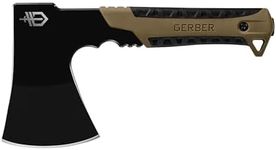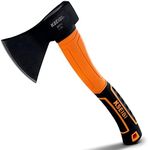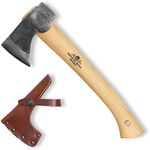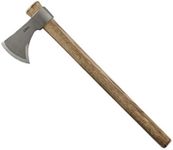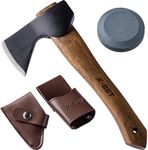Buying Guide for the Best Camp Axes
Choosing the right camp axe is essential for ensuring safety and efficiency during your outdoor adventures. A camp axe is a versatile tool used for chopping wood, clearing paths, and even for some survival situations. To pick the best camp axe for your needs, you should consider several key specifications that will influence its performance and suitability for your specific activities. Understanding these specs will help you make an informed decision and ensure you have the right tool for the job.WeightThe weight of a camp axe is crucial because it affects both the ease of use and the effectiveness of the tool. Lighter axes (around 1-2 pounds) are easier to carry and handle, making them ideal for backpacking and light-duty tasks. Heavier axes (3-5 pounds) provide more power for chopping larger logs and tougher wood but can be more tiring to use over extended periods. Choose a weight that balances your need for portability with the type of tasks you expect to perform.
Handle LengthHandle length impacts the leverage and control you have over the axe. Shorter handles (10-14 inches) are more compact and easier to pack, making them suitable for light chopping and splitting kindling. Longer handles (16-26 inches) offer greater leverage and power, which is beneficial for more demanding tasks like felling trees or splitting larger logs. Consider the type of work you'll be doing and how much space you have in your gear when selecting the handle length.
MaterialThe materials used in both the axe head and handle affect durability, weight, and maintenance. Axe heads are typically made from steel, with high-carbon steel being more durable and holding a sharper edge longer, while stainless steel is more resistant to rust. Handles can be made from wood, fiberglass, or metal. Wooden handles offer a traditional feel and good shock absorption but require more maintenance. Fiberglass and metal handles are more durable and require less upkeep but may transmit more shock to your hands. Choose materials based on your preference for maintenance and durability.
Blade ShapeThe shape of the axe blade influences its cutting efficiency and the types of tasks it can handle. A thinner, more tapered blade is better for precise cutting and carving, while a thicker, wedge-shaped blade is more effective for splitting wood. If you need an all-purpose axe, look for a blade shape that offers a balance between cutting and splitting capabilities. Consider what primary tasks you'll be using the axe for to determine the best blade shape for your needs.
Head DesignThe design of the axe head, including the poll (the back of the axe head), can add versatility to the tool. Some axes have a flat poll that can be used as a hammer for driving tent stakes or other tasks. Others may have a rounded or pointed poll for more specialized uses. Think about whether you need this additional functionality when choosing your camp axe.
Sheath or CoverA sheath or cover is important for protecting the axe blade and ensuring safety when the axe is not in use. Look for a durable sheath that securely covers the blade and can be easily attached to your gear. This will help prevent accidents and keep the blade in good condition. Consider how you plan to carry and store the axe when selecting a sheath or cover.

